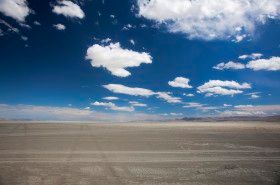
The Burning Man festival, held every year in the USA in the middle of a desert in Nevada, isn’t for the faint hearted or those with fixed notions about humanity. Attending it requires letting go of yourself in every way
It’s a funny thing. I’m cycling in the middle of the desert on a bright pink, sparkly bike, and I am completely lost. I have no map, I’ve got bright red hair to match my wispy, flowing crimson dress (pulled up lungi-style) and I hi-five a passer-by I’ve never met. I have boots, goggles, a dust mask, and pretty much nothing else on, and I feel the free-est I have felt in a long time. Perhaps I feel like I am also not wearing the labels I always have to wear, unrelentlingly, on my forehead, the ones we get so used to that our behaviour flows seamlessly to accommodate them. “Fat Asian guy.” “Old white lady.” “Fuckable chick.” “Black teenager.” “Short Indian man.” In India, we live with these labels so intimately that the term “servant class” doesn’t even seem to bother us; people just love labelling others. I’m sure you know what your own labels are — the prejudices and merits of what people think of you, sometimes subconsciously, even when you don’t say a word.
Imagine existing without them. That’s what burning man felt like to me. You’ve possibly heard of the festival from that friend or acquaintance who seems slightly… different. You’ve possibly brushed it off as not something you would do right now, even if you were a bit intrigued by said friend’s enthusiasm for it. Sure, mad art, music and hippie-style free love sounds great in theory, but with the wife and possibly kids, this is really not something you’ll be allowed to do, even if you wanted to. Or, possibly, like me, you’ve read about it, and you weren’t really opposed to what you saw, perhaps vaguely even liked it, but felt that it was a very expensive way to pretend to have an extreme experience, something that might have moved you when you were 18 but was too much effort for very little payoff right now. “I’m from India, for god’s sake – I’ve worked all my life to survive. I know what extreme experiences are!” You, as I was, would be wrong. Burning Man is a week-long gathering of people in the middle of the Nevada desert in the USA, with ten “principles” thrown in. In 1986, Larry Harvey and Jerry James just sort of decided to burn a man. An effigy was made on a San Fransisco beach, lit up, and a much larger crowd gathered than expected. This is where it all began. In a couple of years, they committed to it fully, and 30 years later it still burns strong. Almost everything at Burning Man — the art, music and steam baths included — are brought by the participants themselves, folks like you and me. On paper, the principles may sound a bit strange to a first-timer. There’s the gifting culture, where there is no barter system or money exchanged, and where random strangers will give you a drink, elaborate jewellery, breakfast or a hug just because they want to. Radical self reliance means you literally have to get your shit together in order to survive; there’s also radical inclusion, leaving no trace of your presence once you’re done, decommodification (where brands have no place) and immediacy — these are my favourites.
Reams of literature is available about the principles, and I imagine they came about in order to communicate that which is the heart of Burning Man. This je ne sais quoi is the reason that so many burners are hooked and keep wanting to go back; it’s also the reason they find it so hard to explain to the folks who haven’t been, but let me try anyway. When presented with this unique set of circumstances — surviving on one’s own in extreme conditions, gifting, surrounded by things that are fantastic yet temporary, actively not judging others and including all that come by — something magical happens. I was at Burning Man this year with friends, and it took us three days to realise that people were stopping to talk to us because that’s just what you do here — there were no ulterior motives, no masks to put up or hide behind. Survival reduces people to their most primal, most open, most vulnerable. You have no choice but to be right there, in the moment. The act of giving freely of oneself and receiving gifts without suspicion is perhaps the most strange and unusual thing — our lives are otherwise so transactional that it takes a few days to actually believe that people can be this nice to each other for no reason.
This transactional way of life seems to extend to our sex lives as well, and many people believe, even subconsciously, that they are “taking” something from their partner that they are supposed to only “give” under certain circumstances. One of the things that the culture of Burning Man underlined for me was that sex is a natural extension of a connection and is a mutual sharing, not something to be “taken” or “given”. If you’re one of those people that thinks that you’re going to get laid a lot at Burning Man because people there are “available”, you’re going to be in for a rude shock — if you aren’t naturally connecting and feel like you’re conning someone, chances are you’re not going to get laid. However, if you get into the flow of things and share yourself and the moment, magic could happen.
This may sound like hippie mumbo-jumbo, but I did see more happy people, grinning from ear to ear, speaking from the heart and feeling a sense of connection, than I ever have at any other gathering, or indeed in any other aspect of my life. And it wasn’t just the drugs. Burning Man is regulated by Nevada State laws — a naked cop could bust you for possession.
Besides the cultural aspect of Burning Man, there’s the visual side of it — it is stunning, vast, endless and spectacular, especially at night, when the fairy lights and dust come out. It is not a spectator event, with most set-ups requiring your active participation, just like the festival itself. Visualise standing in the middle of the open desert at night, a gigantic glowing playground sparkling with every kind of installation, outfit, vehicle and experience you could possibly dream up. Imagine operating a giant Mad Max-style flame thrower above naked dancers begging for the heat of it, and then, two minutes later, lying under a pulsating light installation moving to Beethoven, under the stars. Immediately after that, imagine jiving to retro music from an old-school bus, then hitching a ride on a ship with sails to watch Robot Heart play live.
In the end, what ends up winning is the most powerful drug of all — sleep. Your body stamps its foot and refuses to do any more, despite what your wide-eyed, bushy-tailed mind would like. It sometimes becomes physically impossible to do any more, and you have to retreat to your tent or motor home for quiet conversation around a warm whisky — very good conversation and equally good whisky, in my case, because the single malt tasting camp was nearby.
The culmination of Burning Man is the “the burn”, where most of the bigger structures are set ablaze on the last couple of days, including the beautiful Temple — a structure filled with memories of those loved and lost. Staring at a burning with this community can be a deeply moving experience. While the man itself burns to music, dancing, fireworks and exuberance, the blazing temple is solemn, contemplative and quiet.
Burning Man can make your relationships either stronger than ever or completely unravel, so choose your travel partners wisely. Find a crew that will be both family and give you your space, a caring freedom, if you will, because you will need both. Try not to be MOOP (Matter Out Of Place); being judgmental, not cleaning up after yourself, feeling entitled or general douchebag behaviour makes you MOOP. The term also refers to trash of any kind, which you have to take back with you. And yes, you do have to use porta-potties, so try to locate the one closest to you quickly.
If you do decide to go, it requires some serious planning and commitment. You have to bring your own food, water, shelter, dust goggles and bizarre clothing. It can be, especially when coming from India, a terrifically expensive affair to get there and back, despite the fact that you don’t spend a cent at the venue itself. For a festival that is a great leveller, it automatically excludes those who can’t afford it. That is not the intent, however, and the organisers do their best to compensate with various initiatives such as subsidised tickets, art grants and various forms of outreach. I’m still recovering from the expense, though — it’s the most money I’ve had to spend to survive on my own and on the kindness of strangers. It was worth every cent, though. I’ll be planning ahead this year, so if you’re there, keep an eye out for a bright pink, sparkly bicycle.

















